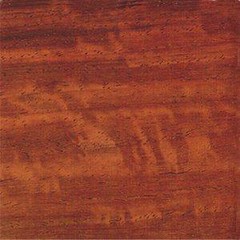What is Padauk Hardwood Flooring?
Fast Facts
Color: Heartwood is vivid reddish orange when freshly cut, darkening to reddish- or purple- brown or black over time. Sapwood is cream-colored. Very uniform in color with a medium luster.
Grain: Straight or interlocked with an oily, coarse texture.
Variations within Species and Grades: Little variation in color.
Hardness/Janka: 1,725, well above average.
Dimensional Stability: Excellent – 5.2.
Sawing/Machining: Saws well and machines easily, but requires slow feed.
Sanding: Sands satisfactorily.
Nailing: No nailing problems.
Finishing: This wood has high oil content; oil-based finishes require long dry times. Water-based finishes or conversion varnishes are recommended.
Availability: Moderately available.
What is Padauk?
Padauk lumber comes from several species with similar properties indigenous to the dense tropical rainforest regions of Central and West Africa. The heartwood is highly prized for its vivid color range, orange to deep crimson that can deepen to almost purple. The grain is straight to interlocked with has low-contrast striping. The lumber has a coarse, oily texture and is exceptionally heavy.
Padauk Usage
Padauk has been prized for centuries for its beauty, durability, scratch resistance and natural pest resistance. It has a spicy smell when unfinished. It is most frequently used in decorative veneers and paneling, high-end joinery, furniture, cabinetry, turnery, carving and sculpting. It is also used for handles, boat-building, agricultural implements, pool tables, inlays and flooring.
Durability
The Janka scale uses 0.444” steel ball pushed into a a 2’’ x 2’’ x 6’’ piece to determine how hard the wood is. The test determines out how many pounds per square inch, or PSI, of force is needed to push the steel ball half way into the wood plank. Padauk is rated at 1725, making it very durable and long wearing. Padauk is highly prized in Italy for flooring and inlaid parquetry. It is manufactured as solid flooring planks or veneer surface for engineered flooring. Solid padauk flooring can be sanded and refinished up to seven times over the life of the floor. High-end engineered flooring may be sanded up to five times. High-end manufactured flooring can be as costly – or more – than solid wood, but has advantages in areas of high humidity and can be installed at or below grade, unlike solid wood. Lower-end engineered flooring can not be sanded, but can be stripped and re-varnished. Read the manufacturers instructions for specific details about your flooring product.
Workability
Padauk presents medium difficulty to work with and must be fed slowly using carbide tools to avoid dulling cutting implements. The sawdust is oily and will stain everything it contacts, and often causes allergic dermatitis and respiratory allergies. It has beautiful color without the need for stain. Oil based products should be avoided as the natural oils in the wood will prevent drying. Pre-boring is recommended but the wood will hold the nails well. Padauk flooring can be floated, nailed, stapled or glued.
Where to use
Padauk’s dramatic beauty and exceptional wearability make it a good choice for almost any room, but it’s best to avoid rooms where standing water is common, like bathrooms. It can stand up to even the heaviest traffic and resists scratching and denting better than most woods. Placing pads under furniture legs, rugs or runners in high traffic areas and keeping pet nails clipped will help protect your floor and keep it looking good for decades.
Care and Maintenance
All wood flooring is easy to care for when treated with respect, but can be dented or scratched from heavy traffic, impacts, spiked shoes, furniture or pet nails. Excess water will stain and damage your beautiful floor, so it is imperative to clean up wet spills immediately. Padauk is an easy-care flooring. Sweeping or vacuuming regularly and an occasional pass with a mop dampened with water mixed with a small amount of white vinegar is all the care generally needed.
Environmental Issues
Worried about choosing a type of “green” flooring? Any wood flooring can be considered green when responsibly farmed and logged. The long-wearing durability alone of a wood floor makes it a sustainable resource, and it is frequently reclaimed and recycled for reuse after decades or even centuries. However, padauk is a rainforest product, imported from areas where the rainforest is often jeopardized for profit. To be responsible, ask questions. Make sure the wood flooring you choose is compliant with the Lacey Act for legal origin and sustainable forestry practices.
